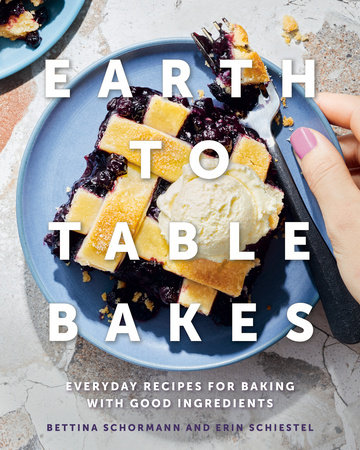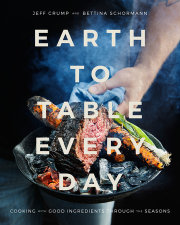Introduction by BETTINA SCHORMANN Erin and I are passionate bakers. We both started out as line cooks, but once we got a taste of baking, we were hooked. We both love the rules, science, and structure of the baking world.
Our history is long—a lovely story that started sixteen years ago, in 2004. I had been the pastry chef at the Ancaster Mill in Ancaster, Ontario, for about four years before Erin came into my life. I didn’t know it at the time, but she was the best thing that would ever happen to me.
When Erin joined the Ancaster Mill, she spent two years in the kitchen working as Garde Manger. In the hierarchy of a kitchen brigade, the Garde Manger is responsible for the preparation and execution of cold food like appetizers and hors d’oeuvres. As the Executive Pastry Chef at that time, I was aware of Erin’s fierce work ethic and attention to detail but had no idea she wanted to make the switch to pastry. In fact, we passed over her twice in favour of other cooks who thought they wanted to be pastry chefs but quickly realized it was not for them once they actually rolled up their sleeves and got to work.
Two years into her time with us, Erin finally spoke up. I was more than happy to have her join the pastry team. I knew she was a hard worker, and despite not having a lot of pastry knowledge, she very quickly became my equal—if not better than me.
The six pastry chefs in our kitchen were responsible for bread service, dining room desserts, special event desserts, wedding desserts, wedding cakes, and the special little treats that customers would receive at the end of their meals known as
petits fours. We worked in a tight 4-×3-metre space and always had to navigate around each other. “Behind!” is a common commercial kitchen call that constantly rang through our tight space. Despite being first in and last to leave, we loved our jobs so much and there wasn’t a lot of complaining. We would work with our music on and dance and sing as much as we could between production and execution. When you spend that much time with someone, you inevitably form a bond. Erin might not know it, but I consider her my best friend.
It was during these years that Erin and I started developing recipes that would end up in this book. The Frangipane Apple Tart (page 204) and the Classic Bread Bar Cheesecake with Rhubarb Compote (page 233) were staple special event desserts for us, and we would often pump out hundreds of individual servings every week. The Citrus Currant Scones (page 73) were very popular for Sunday brunch, so by Saturday we’d have raw scones stockpiled in the freezer so that they could be freshly baked for our devoted brunch crowd. Even though we were a high-production kitchen, we were very fortunate to have embraced a seasonally changing menu as part of the restaurant’s Slow Food philosophy. This meant we always had an excuse to feed our creative appetites: our Classic Bread Bar Cheesecake with Rhubarb Compote (page 233) became a Ricotta Cheesecake with Shortbread Crust and Stewed Strawberries (page 243) in the summer, and then an Acorn Squash Cheesecake with Almond Sablé Cookie Crust and Candied Pecans (page 255) in the fall. There was always a new flavour combination to look forward to.
In 2006, I won Pastry Chef of the Year for Ontario and was offered the opportunity to study in France. Walking the streets of Paris is a culinary school of its own. Shop after shop offered the most scrumptious-looking pastries. The dark crusted croissants and crusty baguettes were perfect. Not to mention all the charcuterie that lined the streets. While I was studying there, I learned many classic French techniques that I have been able to develop and modify for this book, including the ones used in the croissant recipes (pages 225, 236, 247, 259, 275) and the recipe for Blitz Puff Pastry (page 272), which is used as the base for many of our tarts. While I was eating at the best bakeries in the world, I was developing a palate for the kind of food I wanted to produce with Erin.
Shortly after I returned from France, I spent two weeks in New York City working in some of the best restaurants there. On the first day, I was at Jean-Georges with James Beard Award winner Johnny Iuzzini, followed by two days at Per Se, owned by the famous Thomas Keller. I then spent the remaining time at Craft, the James Beard Award–winning restaurant owned by Chef Tom Colicchio. It was there that I had the pleasure of working with Pastry Chef Karen DeMasco. Karen herself is a James Beard Award winner, and I was able to pick her brain for a full week. Her work ethic and hands-on approach were inspirational and have definitely influenced the way I work. She taught me the benefits of making as much as possible from scratch, and not cutting corners just because it’s easier. These lessons furthered my attention to detail and took our kitchen to the next level. In this book, the Blueberry Apple Streusel Muffins (page 85) are a version of Karen’s recipe for Apple Cider Muffins, which she shared with me fourteen years ago. We still make these muffins every day at the restaurant because they are just that good!
In the blink of an eye, Erin and I had been working together at the Ancaster Mill for eight years. I loved my job, but one day I woke up and realized that there was a chance I might miss out on some of the finer things in life, such as getting married and having kids, if I continued to work the way I had been. I switched to part-time hours and started selling my baking at farmers markets instead. My setup was really simple—I would make only the coveted muffins, fresh fruit pies, and bread. It was while working at the farmers market that I cracked the code on the perfect Sweet Pie Dough (page 270) and developed my favourite Crumble Topping (page 284), which I would use on pies and all kinds of other desserts. I also realized how much people appreciate seasonal baking and how satisfying it was to be an entrepreneur.
The market stall was very successful, and I was thinking it might be time to start selling my goodies out of a brick-and-mortar business. At the same time, Jeff Crump, who was then Executive Chef at the Ancaster Mill, was also thinking that he wanted to open his own place—one where he could sell pizza and burgers. It took a third party to inform us that bread and pizza are actually the same thing and require the same equipment for production, and once we’d had our “aha” moment, Jeff and I took our newfound insight to Aaron, the owner of the Ancaster Mill, who quickly agreed to collaborate on a new restaurant. Jeff would be the Chef, I would be the Baker/Pastry Chef, and Aaron would offer his business expertise. Together, the three of us opened Earth to Table: Bread Bar in Hamilton, Ontario, on August 17, 2010.
Not long after we were up and running, I was surprised and blessed by a pregnancy. This is when Erin came back into my life. She seamlessly stepped into the Head Baker/Pastry Chef position at Bread Bar. Erin continued to work as Head Baker when I returned to work as a manger—a position that offered more flexibility. Eventually, she went on to head up production at our second location in Guelph, Ontario, in February 2015. Since writing this book, we’ve opened a third location, also in Hamilton. Erin is the Executive Baker/Pastry Chef for all three and is succeeding in so many ways.
The moment I realized what I was getting into when I decided to write this book, I understood that I could not do it by myself. I also understood that Erin had become a world-class pastry chef, so I asked her to join me in this adventure of writing
Earth to Table Bakes. True to her nature, her contributions have been both wonderful and delicious. This book really is the accumulation of the many years that Erin and I have been working together and learning from each other. Erin has included some of the best doughnut, cake, and croissant recipes she’s developed over the years, and I’ve written up my favourite recipes for cookies, tarts, and savoury treats. Together, we filled in the rest of the gaps. Erin and I have always been a team that works flawlessly together, and we hope you’ll enjoy the fruits of our special relationship that emerge in the pages of this book. Our biggest hope is that these recipes create magical moments and memories in your kitchen, just as they have for us over the years.
HOW TO USE THIS BOOK In
Earth to TableBakes, we bring our philosophy of using locally sourced, high-quality ingredients to some of our favourite sweet and savoury baking recipes. Six chapters that range from Cookies to Bars and Squares to Scones, Muffins, and Biscuits to Loaves and Cakes to Doughnuts, Puffs, and Other Yeasted Goods (including meringues!) to Pies and Tarts (both sweet and savoury!) will satisfy all of your everyday baking needs.
The section that follows those chapters, Four Recipes for Each Season, is subdivided into Spring, Summer, Fall, and Winter and offers a quartet of recipes that highlight the bounty each season has to offer. We’ve included recipes for a seasonal croissant, quiche, pudding, and cheesecake in each one. While we encourage you to use fresh and local ingredients as much as possible throughout the book, the recipes in these sections feature seasonal ingredients and flavours as the star. This was our way of incorporating the Earth to Table philosophy while still offering many other delightful recipes for you to enjoy.
The final section of the book, Staples, includes the component recipes you will see used over and over again in this book. They are often so delicious and versatile that they are used in a variety of ways in many different main recipes.
Alongside many of our recipes, you will find that we’ve added a Kitchen Tip or two. This is where we offer kitchen hacks, ideas for substitutions, notes on ingredients, and other tricks that will help to ensure success with a particular recipe. They can be used alongside the section that follows, Baking Like a Pro, which provides more general tips and techniques for getting the most out of your baking, as well as the Ingredients and Tools and Equipment sections, which will guide you toward setting yourself up for success and help to ensure you get the perfect bake every time you turn on the oven.
In this book, we do not use—and do not recommend that you use—gluten-free flours. Leaving gluten-free flours out of our recipes is a decision we made at Bread Bar after much taste-testing and experimentation, and one that is not always popular. Here, we stick to that decision because these recipes simply will not turn out the way they should if you make substitutions. Having said that, you will find a few gluten-free recipes in this book because they are gluten-free by design. Two examples are Coconut Lover Fantasy Squares (page 51) and Flourless Chocolate Nemesis Cake (page 121), which are made with gluten-free flour, or no flour at all. Both are delicious, which is not always the case in our experience with gluten-free baking. If a recipe in this book is gluten-free, we will let you know.
BAKING LIKE A PRO Compared to baking in a commercial kitchen, baking at home can be tricky. In a commercial kitchen, all of the ingredients and tools are readily available: large bins of flour and sugar, flats of eggs, cases of butter, baking sheets, cake pans—you name it. And there are always multiple mixers at the ready. Sometimes you even get a personal dishwasher! It’s complete luxury. Baking at home is very different. You need to wash your own dishes, make sure you have all of the ingredients before you start baking, and see if you even have the right pan to use. When we bake at home, we face these challenges too, but over the years we’ve found that there are some tips and techniques you can use regardless of where you’re baking.
TIPS FOR BAKING SUCCESS Read the whole recipe. As you prepare to make a recipe, create a pantry list of what you already have. Make sure you have enough on hand to complete the recipe and that the ingredients are the best ones on offer. If you settle for “this will do” or “close enough,” we can almost guarantee that you will not be satisfied with the end result. The same is true for tools and equipment: if you don’t have what you need and proceed with a recipe anyway, you might have a bad baking experience and be less likely to try that recipe again.
Good ingredients matter. Buy the best quality chocolate or the freshest produce you can find. That doesn’t always mean buying the most expensive stuff. Many of the best ingredients are local ones, which travel a shorter distance from producer to consumer and are often less expensive as a result. Any effort you put in to sourcing high-quality ingredients will only add to the mouthwatering textures and flavours of whatever you’re baking.
Use a timer! But only as a reminder that you have something in the oven or on the stove. Every oven is a little different, so ultimately you want to use visual cues and touch or movement tests to confirm doneness. However, if you forget that you were baking altogether, your cake or tart or scone will be ruined before you even get the chance to consider whether it’s ready.
Consider investing in a quality oven thermometer. Ovens can vary in temperature, and the actual temperature inside the oven compared to the readout may be way off. Placing an oven thermometer directly in the oven will help you determine the actual temperature of your oven so you can be sure you’re giving your baked goods the precise heat they need for a successful bake.
You don’t always need to sift. Don’t feel that you must sift the dry ingredients used in a recipe unless you’re specifically instructed to do so. We stopped sifting years ago—in fact, outside of cooking school, I’m not sure we ever sifted. If you need to add air to a batter, it’s much easier to add it by creaming the fat (butter, shortening, or vegetable oil) with the sugar than by sifting the flour. It’s true that cocoa powder, cake flour, and icing sugar can get particularly clumpy, but you can break them up by simply whisking them in a bowl while they’re still dry.
Copyright © 2021 by Bettina Schormann and Erin Schiestel. All rights reserved. No part of this excerpt may be reproduced or reprinted without permission in writing from the publisher.









